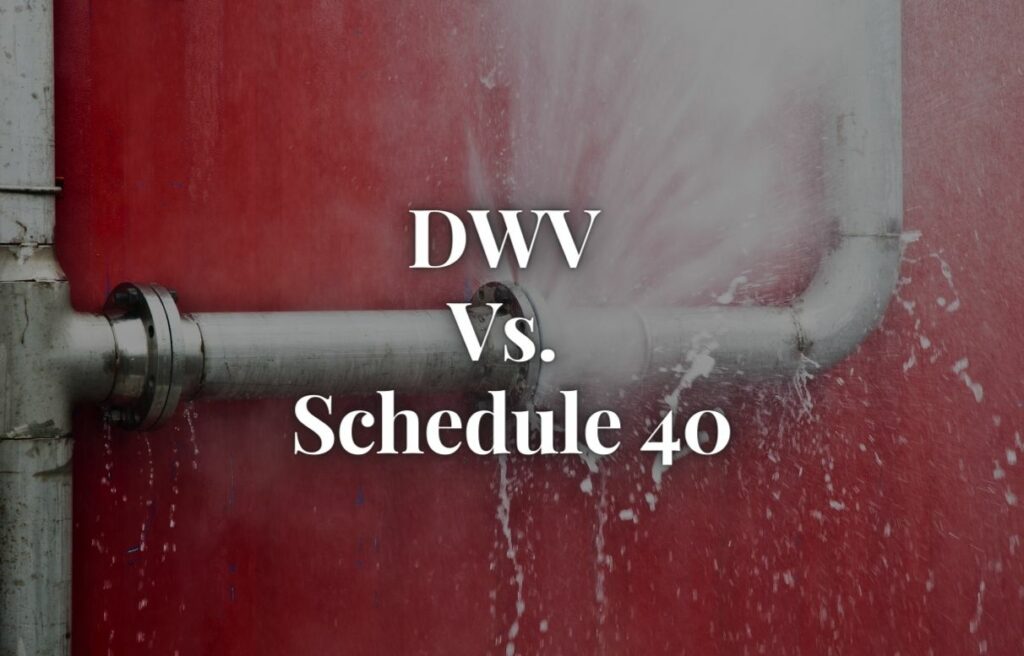DWV pipes are specifically designed for non-pressure applications such as drain lines and vents, while Schedule 40 pipes are used for pressurized applications such as water mains.

Purpose of dWV vs schedule 40
PVC DWV (Drain-Waste-Vent) and Schedule 40 are two types of PVC pipes commonly used in plumbing systems. Both are made of polyvinyl chloride (PVC), but they have different wall thicknesses and pressure ratings. This means they are used for different purposes.
PVC DWV is designed for non-pressurized drainage applications. It has a thinner wall thickness than Schedule 40 PVC, making it less expensive and easier to work with. DWV is commonly used for drains, waste lines, and vents in residential and commercial buildings.
Schedule 40 PVC is designed for low-pressure applications, such as water supply lines, irrigation systems, and gas distribution lines. It has a thicker wall thickness than DWV PVC, making it more durable and able to withstand higher pressures. Schedule 40 is also more resistant to chemicals and UV radiation.
Here is a table summarizing the key differences between PVC DWV and Schedule 40 PVC:
| Feature | PVC DWV | Schedule 40 PVC |
|---|---|---|
| Wall thickness | Thinner | Thicker |
| Pressure rating | Non-pressurized | Low-pressure |
| Applications | Drain, waste, and vent (DWV) systems | Water supply and distribution, gas distribution, heating and cooling systems, fire protection installations |
| Cost | Less expensive | More expensive |
In general, PVC DWV is the best choice for non-pressurized drainage applications, while Schedule 40 PVC is the best choice for low-pressure applications. However, there are some exceptions. For example, Schedule 40 PVC can also be used for DWV applications if the code in your area requires it.
Applications of DWV and Schedule 40
In general, PVC DWV is a good choice for drainage applications where pressure is not a concern, while Schedule 40 PVC is a good choice for water supply and other applications where pressure is required.
Applications of PVC DWV:
- Sink drains
- Toilet drains
- Shower drains
- Vent pipes
Applications of Schedule 40 PVC:
- Water supply lines
- Irrigation systems
- Sump pump discharge lines
- Conduit for electrical wiring
Cost of DWV vs Schedule 40
PVC DWV (Drain-Waste-Vent) is typically less expensive than Schedule 40 PVC. This is because DWV pipe has thinner walls and is not designed for pressurized applications. Schedule 40 PVC, on the other hand, has thicker walls and can withstand higher pressures. This makes it more expensive than DWV pipe.
The exact cost of PVC DWV and Schedule 40 PVC will vary depending on the size, type, and brand of pipe. However, in general, you can expect to pay about 30% to 50% less for DWV pipe than you would for Schedule 40 PVC.
Which is the best option for long-term durability and strength? DWV or Schedule 40?
When it comes to long-term durability and strength, many professionals prefer Schedule 40 over DWV. While both options have their merits, Schedule 40 is renowned for its robustness and lasting power. Some plumbers also favor Schedule 40 for its compatibility with high-pressure applications. It’s always wise to consider all factors when deciding between watts aqualock vs sharkbite.
Can DWV and Schedule 40 PVC pipes be used together?
In general, it is not recommended to use DWV and Schedule 40 PVC pipes together in the same system. This is because the different wall thicknesses of the two types of pipe can cause leaks and other problems. DWV pipe has thinner walls and is not designed to withstand the pressure that can build up in a pressurized system. Schedule 40 pipe, on the other hand, has thicker walls and can withstand higher pressures.
Here are some specific reasons why you should not use DWV and Schedule 40 PVC pipes together:
- The different wall thicknesses of the two types of pipe can cause leaks. When DWV and Schedule 40 PVC pipes are joined together, the thinner walls of the DWV pipe can flex and deform under pressure. This can cause leaks at the joints between the two types of pipe.
- The different materials of the two types of pipe can cause compatibility issues. DWV and Schedule 40 PVC pipes are made from different types of PVC, which can cause compatibility issues. For example, the solvent cement that is used to join DWV pipe may not be compatible with Schedule 40 pipe.
- Using DWV and Schedule 40 PVC pipes together can lead to code violations. In many jurisdictions, it is against code to use DWV and Schedule 40 PVC pipes together in the same system. This is because the different wall thicknesses of the two types of pipe can create safety hazards.
If you need to use PVC pipe for both pressurized and non-pressurized applications, it is best to use only Schedule 40 PVC pipe. Schedule 40 PVC pipe can withstand the pressure of both pressurized and non-pressurized systems, so you will not have to worry about compatibility issues or leaks.

Leave a Reply